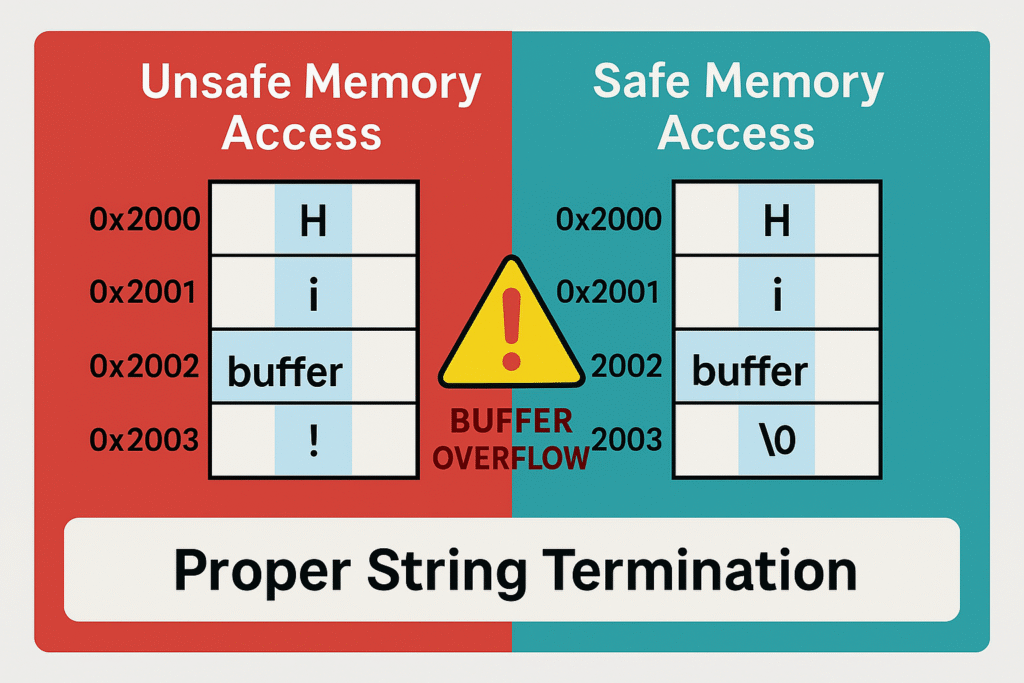Introduction
The safe use of string functions in embedded systems is critical for writing reliable firmware. Functions like strlen, strcpy, and sprintf can cause crashes or memory overflows if used carelessly. These string functions like strlen, strcpy, and sprintf are commonly used for:
- Copying data between buffers
- Measuring string lengths
- Formatting debug messages
- Parsing communication data
These are standard C library functions, and we often use them without a second thought. But in embedded systems — where memory is tight and reliability is critical — careless use of these functions can lead to hard faults, crashes, and unexpected behavior.
Why String Functions Can Be Risky
Let’s take strlen() for example:
size_t strlen(const char *str);This function keeps reading memory until it encounters a null-terminator (\0). But what if:
- Your buffer was not properly terminated?
- It was overwritten or corrupted?
- You’re pointing to uninitialized memory?
The result? Infinite scanning, undefined behavior, or even hard faults on your microcontroller.
Example – Risk of Using strlen()
char buffer[10];
// Suppose the buffer does not contain '\0'
size_t len = strlen(buffer); // ⚠️ Risk of crash or undefined behaviorIf the termination character is missing, the MCU may continue reading memory indefinitely, possibly triggering a memory access violation.
Other Risky Functions and Their Safer Alternatives
Here are common unsafe functions and what you should use instead:
| ❌ Risky Function | ✅ Safer Alternative | Why It’s Safer |
|---|---|---|
strcpy() | strncpy() | Prevents overrun by limiting copied bytes |
sprintf() | snprintf() | Avoids buffer overflows by using length |
strcat() | strncat() | Controls memory use during appending |
strlen() | strnlen() | Avoids out-of-bounds scanning |
How to Use String Functions Safely
✅ 1. Use Bounded Versions of Functions
cCopyEditchar dest[16];
strncpy(dest, src, sizeof(dest) - 1);
dest[sizeof(dest) - 1] = '\0'; // Ensure null termination
Using strncpy with a size limit and enforcing a null-terminator helps prevent accidental overflows.
✅ 2. Validate Input Buffers Before Use
Always ensure the data received over peripherals like UART, BLE, or SPI:
- Has a null-terminator (if expected)
- Is within expected bounds
- Is sanitized before processing
✅ 3. Avoid Dynamic Memory for Strings in Embedded Systems
Avoid using malloc() or calloc() for string buffers in small embedded systems unless absolutely necessary.
Use static or stack-allocated memory for predictability and safety.
Real-World Example: UART Command Parsing
char cmd[32] = {0};
uart_read(cmd, sizeof(cmd)); // Assume safe read
if (strncmp(cmd, "SET TEMP", 8) == 0) {
int temp = atoi(&cmd[9]);
set_temperature(temp);
}
This approach avoids using risky token parsing and keeps memory handling safe.

Conclusion
String functions are essential in embedded development but must be used cautiously.
A simple oversight like a missing null character can crash your firmware.
Always validate inputs, use safer alternatives, and test thoroughly under edge conditions.
Robust string handling = Stable firmware. 💪
What’s Next?
In future posts, I’ll cover:
- Lightweight
printfalternatives for embedded logging - String parsing without memory overhead
- Building reusable command parsers for MCUs
